Climate settings largely determine the welfare of the animals (2/2)
29 January 2024
For a good carefree ventilation in the pig stable, there are a number of points that should always be paid attention to. It is best to have a climate expert carry out an annual climate check for this.
Peter van der Voorst
Independent climate specialist since 1985.
Important points of attention for good climate control:
Here are a number of points that should always be kept in mind:
The temperature probe:
The entire climate control in a pig stable is mainly controlled by the temperature sensor. Of course, it is important that it indicates the correct temperature. It is sometimes said that a deviation of 1°C is not a problem, but with a bandwidth of 5°C this does give a deviation of 20% on the ventilation amount. Then there is 20% too much or 20% too little ventilation. In most climate computers, the reading of the temperature sensor can be calibrated. The temperature sensors that have come on the market in recent years are better and better. A regular check is always a good thing to do, of course a check in the right way and with the right equipment.
The temperature sensor must be installed on the right place in the compartment or barn. A common mistake is that the temperature sensor hangs in the incoming air flow and then always a lower temperature is indicated than it actually is at animal level.
Moments of yes/no in the airflow is even worse. As a result, the amount of ventilation will also fluctuate greatly.
It is therefore best to hang the temperature sensor outside the incoming air flow, and above the animals at such a height that they cannot reach it. In practice, this is usually at least 60 cm. besides the control corridor and at least 120 cm. above the floor.
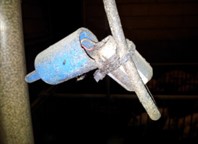
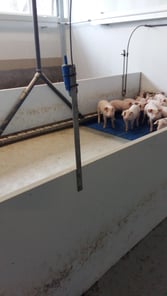
Not like this But like this
The climate computer:
There are many different climate computers on the market. Almost all of them work according to the same principles, but nowadays there are so many setting options that because of that more and more wrong settings are made. This includes all kinds of corrections to temperature and ventilation settings. Also in companies where several employees work, it often happens that all many different corrections to the climate curve have been made, which are then not removed. A regular check for the correct settings is therefore also recommended.
It should be the case that a climate curve is set once for the whole year. In that case, the pig farmer only has to set the day number to 1 when new animals are entering and, if possible, enter the number of animals.
Each animal category has different temperature requirements and requirements for minimum and maximum ventilation. These are described at the beginning of the article.
Wind influences:
The wind can have a major influence on the air distribution in the barn or compartment if not sufficient measures have been taken to limit this as much as possible.
Especially in colder periods, when there is little ventilation and therefore little negative pressure in the barn. The wind is always unpredictable and in gusts. For this reason, it can happen that there suddenly is more cold air blown in by the wind. This is experienced by the animals as a draught and the also the changes are bad for the animals.
There are now many ways to limit these wind influences:
-
First of all, the air inlet must be designed for what needs to be ventilated at maximum ventilation. The basis for this is at least 1 cm²/m3 of air to be ventilated. This corresponds to 5 Pa differential pressure. This air inlet is then only necessary if there is maximum ventilation.
-
For a large part of the year, there is no maximum ventilation and the air inlet should therefore be smaller. Manual adjustment is not an option. After all, people are always late. So the best thing is to automate this. This can be done on average ventilation in the house or on pressure difference (5 Pa).
-
Some examples of limiting wind influence:
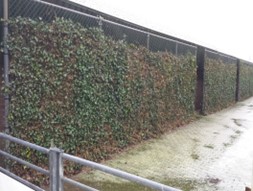
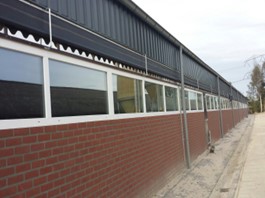
Natural vegetation Automatic control
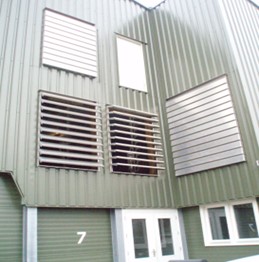
Automatic control
Cooling of pig barns:
In recent years we have seen increasingly hot summers, pigs are really suffering from these higher temperatures. It is important not to let the barn temperature rise too high. Farrowing sows will eat less and therefore produce less milk. This in turn is negative for the piglets. In fattening pigs, we also clearly see that feed intake and thus growth will decrease above a barn temperature of ± 25°C.
Cooling the incoming air is therefore necessary and always pays for itself back.
The most common method of cooling is with water mist or pad cooling. Other methods, such as ground pipes or groundwater cooling, are also very effective, but much more expensive to install. These are both systems that do not depend on the humidity of the outside air. But this is the case with mist cooling and pad cooling. The lower the air humidity outside, the better it can be cooled. After all, it is the evaporation of water with which the heat is extracted from the air.
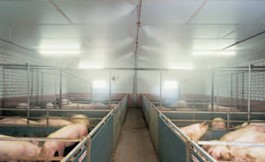
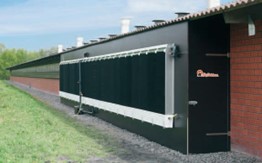
Mist cooling Pad-cooling
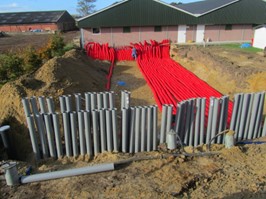
Ground tubes
Summarizing:
Correct settings in the climate computer are very important, but the built-in air inlet system must also meet the right requirements. The temperature probe must indicate the correct temperature and measures must be made to limit the wind influences as much as possible. Cooling of pig stable is also becoming an increasingly important option.
All the points mentioned require a specialist approach. Continuous monitoring with sensors is now very possible and provides increasingly better insights into what is happening in the barn every minute. Based on these measurements, it is easier to adjust settings.
